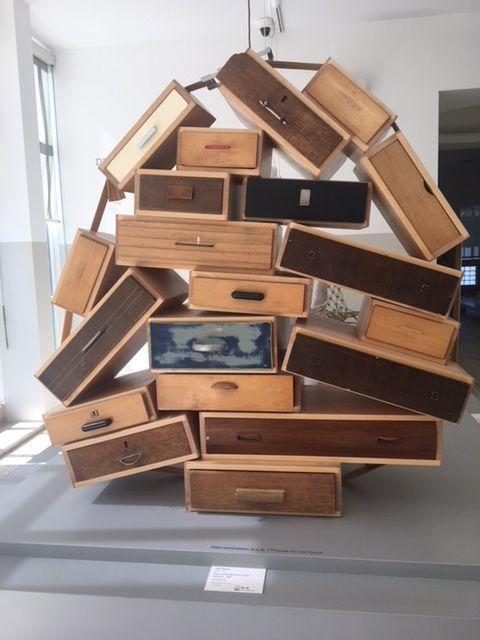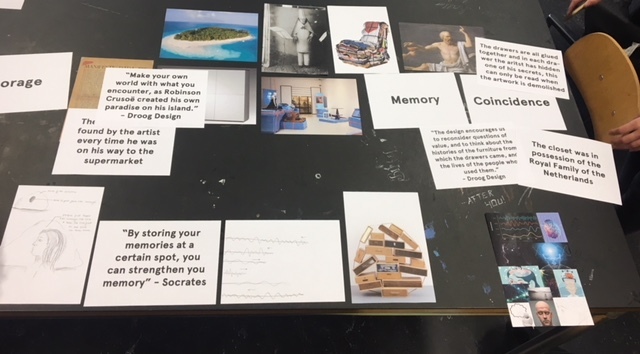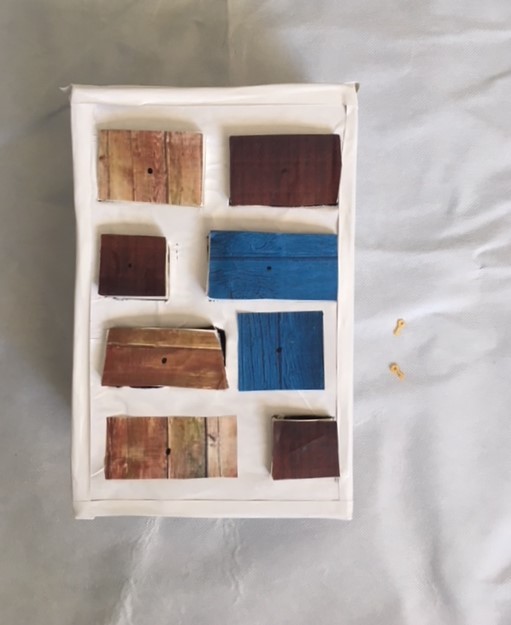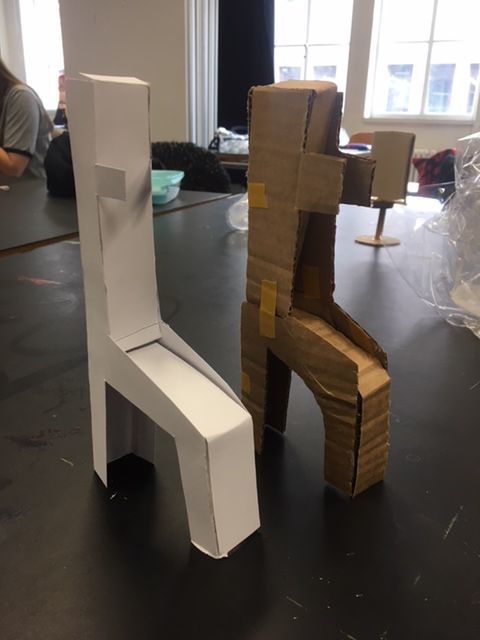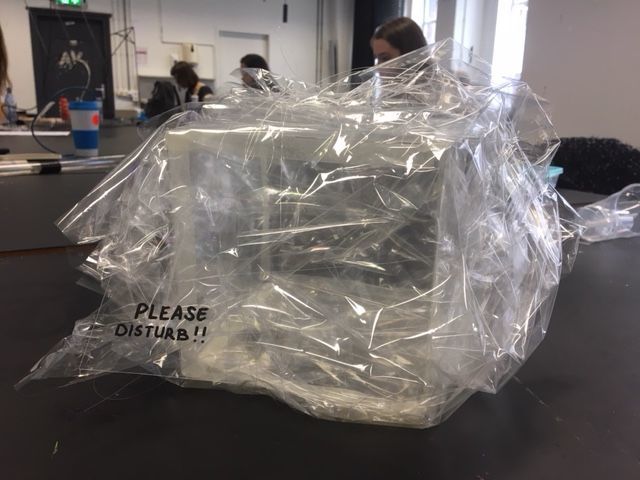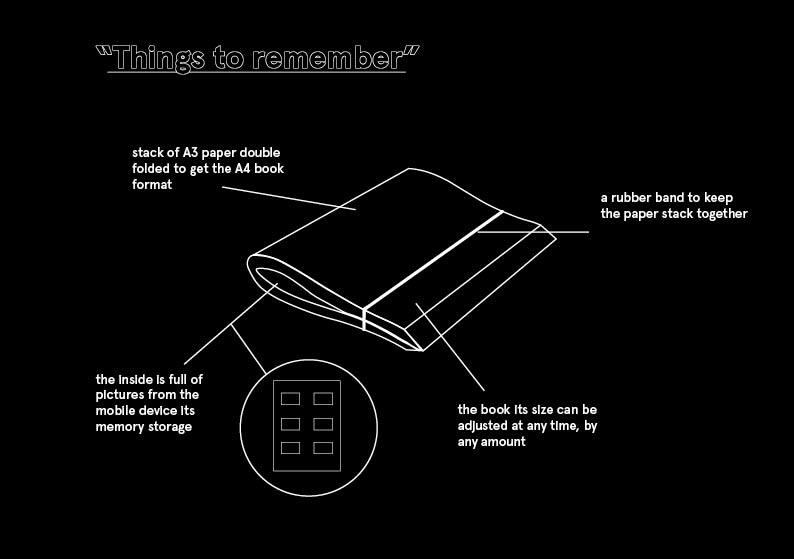Difference between revisions of "User:Evaschoren"
Evaschoren (talk | contribs) |
Evaschoren (talk | contribs) |
||
| Line 91: | Line 91: | ||
For the reproduction of the artefact I dove in to the subject of memories and how they exist in today's society. I found out that a big part of them are on our mobile devices. On your device it is hard to see the total amount of memories, in this case pictures. But when you make them analogue, it becomes clear how much there actually are. I decided to focuss on the memory storage of pictures, because they exist on everyone their phones. I made the reproduction of the artwork in the form of a book. The book is a visual storage for all the digital pictures from my mobile phone. It is the artwork from Tejo Remy, translated in another medium, but the idea of the memory storage has been reproduced in here. I made a photo book out of all the pictures stored on my device. The book is built up out of double folded pages, stacked on each other and kept together with a band, just like the closet of Remy. It can be updated and elaborated anytime, just by folding an A3 on top of the stack, and placing the band over it again. When you flip through the book, it becomes clear how much there actually is on your phone, and how much there is stored on there which you are not aware of. Out of this photo book came my contemporary translation of the artwork. Which will make you more aware of this huge memory storage which your mobiel phone has become. | For the reproduction of the artefact I dove in to the subject of memories and how they exist in today's society. I found out that a big part of them are on our mobile devices. On your device it is hard to see the total amount of memories, in this case pictures. But when you make them analogue, it becomes clear how much there actually are. I decided to focuss on the memory storage of pictures, because they exist on everyone their phones. I made the reproduction of the artwork in the form of a book. The book is a visual storage for all the digital pictures from my mobile phone. It is the artwork from Tejo Remy, translated in another medium, but the idea of the memory storage has been reproduced in here. I made a photo book out of all the pictures stored on my device. The book is built up out of double folded pages, stacked on each other and kept together with a band, just like the closet of Remy. It can be updated and elaborated anytime, just by folding an A3 on top of the stack, and placing the band over it again. When you flip through the book, it becomes clear how much there actually is on your phone, and how much there is stored on there which you are not aware of. Out of this photo book came my contemporary translation of the artwork. Which will make you more aware of this huge memory storage which your mobiel phone has become. | ||
| − | [[File: | + | [[File:BlueprintBOOKsmall2.jpg]] |
Revision as of 18:44, 7 May 2018
Digital Craft
For the first lesson we went to Boijmans van Beuningen and chose and artefact. Here I found several interesting objects. And at first I choose Chaise Lounge Model 313, 1932 by Marcel Breuer. But that afternoon I decided to change my artefact for anoter intersting one, because I had no inspiration for the first one. My new arteface is You can not lay down your memories by Tejo Remy.I got a lot more inspired by this artefact, especially by its form and name.
Assignement 1
20 printed A5 images about some research of the chosen artefact
Assignment 2
Use the artefact of your groupmate and create a contrafactual past and a speculative future for the artefacts
Statement of the artefact and its relation to the “Cutting edge of the present”
“You can not lay down your memory”
Your memory is something very personal. You can choose wether to share them, or to keep them to yourself. You can spread them by showing others, and keep them private by leaving them in your head, where no one has access to it.
These days our mobile devices become more and more important to us. They became part of our lives, and by that, part of our memories. An important feature of these mobile devices is that they can hold tons of memories for you. Some you might even have forgotten.
The most common way to store these memories on your phone will be though pictures. You make them every time you see something nice, something important, something shocking, and so on. They are being stored at your camera roll, for days, other months and others for years. A lot of these pictures don’t appear anywhere else but in this camera roll. They are being stored there for several years, and yet, you still don’t print them out, share them on social media or even throw them away.
This is a fascinating aspect of our connection to memories and our phones. They become a certain storage for our memories. We store our memories in the form of pictures, and take a look at them once a few weeks. We determine ourselves wether to make them public, or keep them private.
Contrafactual past
Past Dresser by Zoe van Peperstraten
Eva chose to focus on the artwork You can not lay down your memory made by the artist Tejo Remy. The artwork shows different layers tied together. It is a symbol of memories. For this assignment I had to make a contrafactual past. I made a dresser with different layers and keys. My dresser resembles the memory of a young child. There are not a lot of memory's yet. So there are not a lot of layers. Every layer is a memory, so the more memories there are, the more layers there will be. So I think the original artwork resembles the memories of an adult. It is falling apart and hold together with a rope, because there are more memories. In my prototype I put some keys with it. Every key opens a memory, in the memory there is a sound or smell. Because this is a prototype there is no actual sound or smell.
Speculative future Future dresser bij Floris Beuger
Contrafactual past
Past chair by Eva Schoren
The sexy relaxy is a chair which makes you sit in a certain way. The chair forces you to spread your legs. By this, it also forces women to open their legs, which creates a sexual tension. This chair was inspired by the chairs back in the days, specially designed for little girls.
Back in the days, it was necessarily for women to sit in a certain way. Their sitting posture was connected to a certain social rule. They had to sit straight up, legs crossed over each other and their chin up.
A lot of mothers had trouble to cope with teaching their little girls to sit in the right way. They simply did not do it right at all. Luckily for the mothers their little girls were being sent to girls school, where they learned all the important stuff they should know when becoming a house mom by their selves one day. Knitting, cooking, cleaning, but also sitting in the right way. The schools for girls had a smart way to learn these girls to sit in the right way. They developed a chair, which forces them to sit in a certain way. Their back had to be straight up, their chin should be up in the sky, their legs crossed over each other and their arms resting on their lap. The chair made sure of it all, and by doing all the work in this chair, they learned how to sit in the right way.
Speculative future
Future artefact by Eva Schoren
The L’Enigme d’Isidore Ducasse (The Enigma of Isidore Ducasse) is a secret object, wrapped in a blanket, leaving a lot to the imagination of the viewer. No one knows exactly what is behind the blanket, only the artist itself.
We live in a world where almost everything is accessible, so this object becomes extra appealing for us because in a way we can not access it. Looking to the future, we will enter an era where there are no such things as secrets anymore. Nothing can be hidden for one other and everything has to be there and has to be able to being read.
In the future this accessibility will be even more available. Everything is being shared more and more, and eventually, in the far futrure, there will be no secrets anymore, anywhere. Everything has been shared. Everything needs to be transparent for everyone. So does the artifact. There are no secrets anymore in the world, so the artifact does not contain a secret anymore as well. It is a completely transparent box, which contains nothing and can be see through by everyone. It is wrapped up, but with transparent paper and a transparent line so you are still able to see through everything and be ensured there is nothing hidden anymore.
A reproduction
A reproduction of (texture, form, idea or process) your artefact using digital fabrication technologies.
For the reproduction of the artefact I dove in to the subject of memories and how they exist in today's society. I found out that a big part of them are on our mobile devices. On your device it is hard to see the total amount of memories, in this case pictures. But when you make them analogue, it becomes clear how much there actually are. I decided to focuss on the memory storage of pictures, because they exist on everyone their phones. I made the reproduction of the artwork in the form of a book. The book is a visual storage for all the digital pictures from my mobile phone. It is the artwork from Tejo Remy, translated in another medium, but the idea of the memory storage has been reproduced in here. I made a photo book out of all the pictures stored on my device. The book is built up out of double folded pages, stacked on each other and kept together with a band, just like the closet of Remy. It can be updated and elaborated anytime, just by folding an A3 on top of the stack, and placing the band over it again. When you flip through the book, it becomes clear how much there actually is on your phone, and how much there is stored on there which you are not aware of. Out of this photo book came my contemporary translation of the artwork. Which will make you more aware of this huge memory storage which your mobiel phone has become.
A contemporary transformation
A well-fabricated contemporary transformation of your chosen artefact, positioned in a new context
For the contemporary transformation of the art object I went further on the idea I had explored during the making of the reproduction of my artefact: the huge amount of memories stored on your mobile device. A lot of these you have already forgotten. To make the people more aware of this, I decided to create an app which forces you to make a selection of 10 memories which are the most important to you. This can be a picture, text, audio, a contact or a location. It is all up to you, as long as you can make a selection of 10 memories out of the thousands stored on your device. It makes you reconsider which things are actually important, and which things you absolutely do not want to forget. To consider this again, your most valuable memories become meaningful again. The storage of the app is limited, and you decide what you put in there, just like a drawer.
